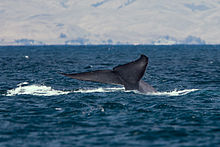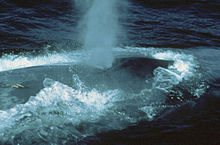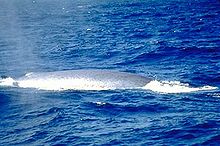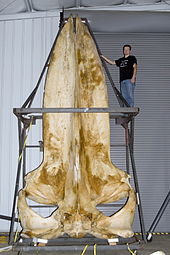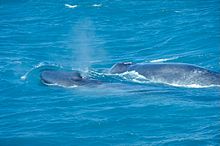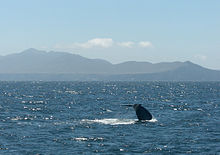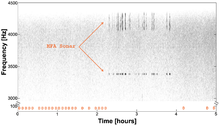
Blue whale
About this schools Wikipedia selection
SOS Children made this Wikipedia selection alongside other schools resources. With SOS Children you can choose to sponsor children in over a hundred countries
| Blue whale | |
|---|---|
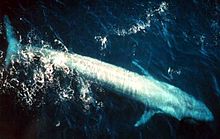 |
|
| Adult blue whale from the eastern Pacific Ocean | |
| Size compared to an average human | |
| Conservation status | |
 Endangered ( IUCN 3.1) |
|
| Scientific classification | |
| Kingdom: | Animalia |
| Phylum: | Chordata |
| Class: | Mammalia |
| Order: | Cetacea |
| Suborder: | Mysticeti |
| Family: | Balaenopteridae |
| Genus: | Balaenoptera |
| Species: | B. musculus |
| Binomial name | |
| Balaenoptera musculus (Linnaeus, 1758) |
|
| Subspecies | |
|
|
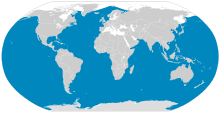 |
|
| Blue whale range (in blue) | |
| Synonyms | |
|
|
The blue whale (Balaenoptera musculus) is a marine mammal belonging to the suborder of baleen whales (called Mysticeti). At 30 metres (98 ft) in length and 180 tonnes (200 short tons) or more in weight, it is the largest known animal to have ever existed.
Long and slender, the blue whale's body can be various shades of bluish-grey dorsally and somewhat lighter underneath. There are at least three distinct subspecies: B. m. musculus of the North Atlantic and North Pacific, B. m. intermedia of the Southern Ocean and B. m. brevicauda (also known as the pygmy blue whale) found in the Indian Ocean and South Pacific Ocean. B. m. indica, found in the Indian Ocean, may be another subspecies. As with other baleen whales, its diet consists almost exclusively of small crustaceans known as krill.
Blue whales were abundant in nearly all the oceans on Earth until the beginning of the twentieth century. For over a century, they were hunted almost to extinction by whalers until protected by the international community in 1966. A 2002 report estimated there were 5,000 to 12,000 blue whales worldwide, located in at least five groups. More recent research into the Pygmy subspecies suggests this may be an underestimate. Before whaling, the largest population was in the Antarctic, numbering approximately 239,000 (range 202,000 to 311,000). There remain only much smaller (around 2,000) concentrations in each of the eastern North Pacific, Antarctic, and Indian Ocean groups. There are two more groups in the North Atlantic, and at least two in the Southern Hemisphere.
Taxonomy
Blue whales are rorquals (family Balaenopteridae), a family that includes the humpback whale, the fin whale, Bryde's whale, the sei whale, and the minke whale. The family Balaenopteridae is believed to have diverged from the other families of the suborder Mysticeti as long ago as the middle Oligocene. It is not known when the members of those families diverged from each other.
The blue whale is usually classified as one of eight species in the genus Balaenoptera; one authority places it in a separate monotypic genus, Sibbaldus, but this is not accepted elsewhere. DNA sequencing analysis indicates that the blue whale is phylogenetically closer to the sei whale (Balaenoptera borealis) and Bryde's whale (Balaenoptera brydei) than to other Balaenoptera species, and closer to the humpback whale (Megaptera) and the gray whale (Eschrichtius) than to the minke whales (Balaenoptera acutorostrata and Balaenoptera bonaerensis). If further research confirms these relationships, it will be necessary to reclassify the rorquals.
There have been at least 11 documented cases of blue/ fin hybrid adults in the wild. Arnason and Gullberg describe the genetic distance between a blue and a fin as about the same as that between a human and a gorilla. Researchers working off Fiji believe they photographed a hybrid humpback/blue whale.
The first published description of the blue whale comes from Robert Sibbald's Phalainologia Nova (1694). In September 1692, Sibbald found a blue whale that had stranded in the Firth of Forth—a male 78-feet-long—which had "black, horny plates" and "two large apertures approaching a pyramid in shape".
The specific name musculus is Latin and could mean "muscle", but it can also be interpreted as "little mouse". Carl Linnaeus, who named the species in his seminal Systema Naturae of 1758, would have known this and may have intended the ironic double meaning. Herman Melville called this species sulphur-bottom in his novel Moby-Dick due to an orange-brown or yellow tinge on the underparts from diatom films on the skin. Other common names for the blue whale have included Sibbald's rorqual (after Sibbald, who first described the species), the great blue whale and the great northern rorqual. These names have now fallen into disuse. The first known usage of the term blue whale was in Melville's Moby-Dick, which only mentions it in passing and does not specifically attribute it to the species in question. The name was really derived from the Norwegian blåhval, coined by Svend Foyn shortly after he had perfected the harpoon gun; the Norwegian scientist G. O. Sars adopted it as the Norwegian common name in 1874.
Authorities classify the species into three or four subspecies: B. m. musculus, the northern blue whale consisting of the North Atlantic and North Pacific populations, B. m. intermedia, the southern blue whale of the Southern Ocean, B. m. brevicauda, the pygmy blue whale found in the Indian Ocean and South Pacific, and the more problematic B. m. indica, the great Indian rorqual, which is also found in the Indian Ocean and, although described earlier, may be the same subspecies as B. m. brevicauda.
Description and behaviour
The blue whale has a long tapering body that appears stretched in comparison with the stockier build of other whales. The head is flat, U-shaped and has a prominent ridge running from the blowhole to the top of the upper lip. The front part of the mouth is thick with baleen plates; around 300 plates (each around one metre (3.2 ft) long) hang from the upper jaw, running 0.5 m (1.6 ft) back into the mouth. Between 70 and 118 grooves (called ventral pleats) run along the throat parallel to the body length. These pleats assist with evacuating water from the mouth after lunge feeding (see feeding below).
The dorsal fin is small, ranging in height from 8–70 centimeters (3.1–28 in) (usually 20–40 centimeters (7.9–16 in)) and averaging about 28 centimetres (11 in). It is visible only briefly during the dive sequence. Located around three-quarters of the way along the length of the body, it varies in shape from one individual to another; some only have a barely perceptible lump, but others may have prominent and falcate (sickle-shaped) dorsals. When surfacing to breathe, the blue whale raises its shoulder and blowhole out of the water to a greater extent than other large whales, such as the fin or sei whales. Observers can use this trait to differentiate between species at sea. Some blue whales in the North Atlantic and North Pacific raise their tail fluke when diving. When breathing, the whale emits a spectacular vertical single-column spout up to 12 metres (39 ft), typically 9 metres (30 ft). Its lung capacity is 5,000 litres (1320 U.S. gallons). Blue whales have twin blowholes shielded by a large splashguard.
The flippers are 3–4 metres (9.8–13 ft) long. The upper sides are grey with a thin white border; the lower sides are white. The head and tail fluke are generally uniformly grey. The whale's upper parts, and sometimes the flippers, are usually mottled. The degree of mottling varies substantially from individual to individual. Some may have a uniform slate-grey colour, but others demonstrate a considerable variation of dark blues, greys and blacks, all tightly mottled.
Blue whales can reach speeds of 50 kilometres per hour (31 mph) over short bursts, usually when interacting with other whales, but 20 kilometres per hour (12 mph) is a more typical traveling speed. When feeding, they slow down to 5 kilometres per hour (3.1 mph).
Blue whales most commonly live alone or with one other individual. It is not known how long traveling pairs stay together. In locations where there is a high concentration of food, as many as 50 blue whales have been seen scattered over a small area. They do not form the large, close-knit groups seen in other baleen species.
Physical description
Size
The blue whale is the largest animal ever known to have lived. The largest known dinosaur of the Mesozoic Era was Amphicoelias, which is estimated to have weighed up to 122 metric tons (134 short tons).
Blue whales are difficult to weigh because of their size. As is the case with most large whales targeted by whalers, adult blue whales have never been weighed whole, but cut up into manageable pieces first. This caused an underestimate of the total weight of the whale, due to the loss of blood and other fluids. Nevertheless, measurements between 150–170 metric tons (170–190 short tons) were recorded of animals up to 27 metres (89 ft) in length. The weight of an individual 30 metres (98 ft) long is believed by the American National Marine Mammal Laboratory (NMML) to be in excess of 180 metric tons (200 short tons). The largest blue whale accurately weighed by NMML scientists to date was a female that weighed 177 metric tons (195 short tons). As a whole, blue whales from the Northern Atlantic and Pacific appear to be smaller on average than those from sub-Antarctic waters.
There is some uncertainty about the biggest blue whale ever found, as most data come from blue whales killed in Antarctic waters during the first half of the twentieth century, and was collected by whalers not well-versed in standard zoological measurement techniques. The heaviest whale ever recorded weighed in at 190 metric tons (210 short tons). The longest whales ever recorded were two females measuring 33.6 metres (110 ft) and 33.3 metres (109 ft), although in neither of these cases was the piecemeal weight gathered. The longest whale measured by scientists at the NMML was 29.9 metres (98 ft), a female caught in the Antarctic by Japanese whalers in 1946–47. Lieut. Quentin R. Walsh, USCG, while acting as whaling inspector of the factory ship Ulysses, verified the measurement of a 30 m (98 ft) pregnant blue whale caught in the Antarctic in the 1937–38 season. The longest reported in the North Pacific was a 27.1 metres (89 ft) female taken by Japanese whalers in 1959, and the longest reported in the North Atlantic was a 28.1 metres (92 ft) female caught in the Davis Strait.
Due to its large size, several organs of the blue whale are the largest in the animal kingdom. A blue whale's tongue weighs around 2.7 metric tons (3.0 short tons) and, when fully expanded, its mouth is large enough to hold up to 90 metric tons (99 short tons) of food and water. Despite the size of its mouth, the dimensions of its throat are such that a blue whale cannot swallow an object wider than a beach ball. Its heart weighs 600 kilograms (1,300 lb) and is the largest known in any animal. A blue whale's aorta is about 23 centimetres (9.1 in) in diameter. During the first seven months of its life, a blue whale calf drinks approximately 400 litres (110 US gal) of milk every day. Blue whale calves gain weight quickly, as much as 90 kilograms (200 lb) every 24 hours. Even at birth, they weigh up to 2,700 kilograms (6,000 lb)—the same as a fully grown hippopotamus. Blue whales have relatively small brains, only about 6.92 kilograms (15.26 lb) , about 0.007% of its body weight.
Feeding
Blue whales feed almost exclusively on krill, though they also take small numbers of copepods. The species of this zooplankton eaten by blue whales varies from ocean to ocean. In the North Atlantic, Meganyctiphanes norvegica, Thysanoessa raschii, Thysanoessa inermis and Thysanoessa longicaudata are the usual food; in the North Pacific, Euphausia pacifica, Thysanoessa inermis, Thysanoessa longipes, Thysanoessa spinifera, Nyctiphanes symplex and Nematoscelis megalops; and in the Antarctic, Euphausia superba, Euphausia crystallorophias and Euphausia valentini.
An adult blue whale can eat up to 40 million krill in a day. The whales always feed in the areas with the highest concentration of krill, sometimes eating up to 3,600 kilograms (7,900 lb) of krill in a single day. This daily requirement of an adult blue whale is in the region of 1.5 million kilocalories.
Because krill move, blue whales typically feed at depths of more than 100 metres (330 ft) during the day and only surface-feed at night. Dive times are typically 10 minutes when feeding, though dives of up to 20 minutes are common. The longest recorded dive is 36 minutes. The whale feeds by lunging forward at groups of krill, taking the animals and a large quantity of water into its mouth. The water is then squeezed out through the baleen plates by pressure from the ventral pouch and tongue. Once the mouth is clear of water, the remaining krill, unable to pass through the plates, are swallowed. The blue whale also incidentally consumes small fish, crustaceans and squid caught up with krill.
Life history
Mating starts in late autumn and continues to the end of winter. Little is known about mating behaviour or breeding grounds. Females typically give birth once every two to three years at the start of the winter after a gestation period of 10 to 12 months. The calf weighs about 2.5 metric tons (2.8 short tons) and is around 7 metres (23 ft) in length. Blue whale calves drink 380–570 litres (100–150 U.S. gallons) of milk a day. The calf is weaned after six months, by which time it has doubled in length. Sexual maturity is typically reached at five to ten years of age. In the Northern Hemisphere, whaling records show that males averaged 20–21 m (65.6–69 ft) and females 21–23 m (69–75 ft) at sexual maturity, while in the Southern Hemisphere it was 22.6 m (74 ft) and 24 m (79 ft), respectively. In the Southern Hemisphere, as adults, males averaged 25 m (82 ft) and females 26.5 m (87 ft). In the North Pacific, photogrammetric studies have shown blue whale adults today average 21.6 m (71 ft), with a maximum of over 24.4 m (80 ft) – although a 26.5 m (87 ft) female stranded near Pescadero, California in 1979.
Scientists estimate that blue whales can live for at least 80 years; though since individual records do not date back into the whaling era, this will not be known with certainty for many years. The longest recorded study of a single individual is 34 years, in the eastern North Pacific. The whales' only natural predator is the orca. Studies report that as many as 25% of mature blue whales have scars resulting from orca attacks. The mortality rate of such attacks is unknown.
Blue whale strandings are extremely uncommon, and, because of the species' social structure, mass strandings are unheard of. When strandings do occur, they can become the focus of public interest. In 1920, a blue whale washed up near Bragar on the Isle of Lewis in the Outer Hebrides of Scotland. It had been shot by whalers, but the harpoon had failed to explode. As with other mammals, the fundamental instinct of the whale was to try to carry on breathing at all costs, even though this meant beaching to prevent itself from drowning. Two of the whale's bones were erected just off a main road on Lewis and remain a tourist attraction.
Vocalizations
 |
Multimedia relating to the blue whale
Note that the whale calls have been sped up 10x from their original speed.
A blue whale song
Recorded in the Atlantic (1)
A blue whale song
Recorded in the Atlantic (2)
A blue whale song
Recorded in the Atlantic (3)
A blue whale song
Recorded in North Eastern Pacific
A blue whale song
Recorded in the South Pacific
A blue whale song
Recorded in the West Pacific
|
| Problems listening to these files? See media help. | |
Estimates made by Cummings and Thompson (1971) suggest the source level of sounds made by blue whales are between 155 and 188 decibels when measured relative to a reference pressure of one micropascal at one metre. All blue whale groups make calls at a fundamental frequency between 10 and 40 Hz; the lowest frequency sound a human can typically perceive is 20 Hz. Blue whale calls last between ten and thirty seconds. Blue whales off the coast of Sri Lanka have been repeatedly recorded making "songs" of four notes, lasting about two minutes each, reminiscent of the well-known humpback whale songs. As this phenomenon has not been seen in any other populations, researchers believe it may be unique to the B. m. brevicauda (pygmy) subspecies.
The reason for vocalization is unknown. Richardson et al. (1995) discuss six possible reasons:
- Maintenance of inter-individual distance
- Species and individual recognition
- Contextual information transmission (for example feeding, alarm, courtship)
- Maintenance of social organization (for example contact calls between females and males)
- Location of topographic features
- Location of prey resources
Population and whaling
Hunting era
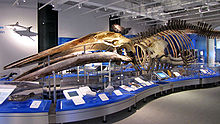
Blue whales are not easy to catch or kill. Their speed and power meant that they were rarely pursued by early whalers, who instead targeted sperm and right whales. In 1864, the Norwegian Svend Foyn equipped a steamboat with harpoons specifically designed for catching large whales. Although it was initially cumbersome and had a low success rate, Foyn perfected the harpoon gun, and soon several whaling stations were established on the coast of Finnmark in northern Norway. Because of disputes with the local fishermen, the last whaling station in Finnmark was closed down in 1904.
Soon, blue whales were being hunted off Iceland (1883), the Faroe Islands (1894), Newfoundland (1898), and Spitsbergen (1903). In 1904–05 the first blue whales were taken off South Georgia. By 1925, with the advent of the stern slipway in factory ships and the use of steam-driven whale catchers, the catch of blue whales, and baleen whales as a whole, in the Antarctic and sub-Antarctic began to increase dramatically. In the 1930–31 season, these ships caught 29,400 blue whales in the Antarctic alone. By the end of World War II, populations had been significantly depleted, and, in 1946, the first quotas restricting international trade in whales were introduced, but they were ineffective because of the lack of differentiation between species. Rare species could be hunted on an equal footing with those found in relative abundance.
Arthur C. Clarke, in his 1962 book Profiles of the Future, was the first prominent intellectual to call attention to the plight of the blue whale. He mentioned its large brain and said, "we do not know the true nature of the entity we are destroying."
Blue whale hunting was banned in 1966 by the International Whaling Commission, and illegal whaling by the USSR finally halted in the 1970s, by which time 330,000 blue whales had been caught in the Antarctic, 33,000 in the rest of the Southern Hemisphere, 8,200 in the North Pacific, and 7,000 in the North Atlantic. The largest original population, in the Antarctic, had been reduced to 0.15% of their initial numbers.
Population and distribution today
Since the introduction of the whaling ban, studies have failed to ascertain whether the conservation reliant global blue whale population is increasing or remaining stable. In the Antarctic, best estimates show a significant increase at 7.3% per year since the end of illegal Soviet whaling, but numbers remain at under 1% of their original levels. It has also been suggested that Icelandic and Californian populations are increasing but these increases are not statistically significant. The total world population was estimated to be between 5,000 and 12,000 in 2002, although there are high levels of uncertainty in available estimates for many areas.
The IUCN Red List counts the blue whale as "endangered" as it has since the list's inception. In the United States, the National Marine Fisheries Service lists them as endangered under the Endangered Species Act. The largest known concentration, consisting of about 2,800 individuals, is the northeast Pacific population of the northern blue whale (B. m. musculus) subspecies that ranges from Alaska to Costa Rica, but is most commonly seen from California in summer. Infrequently, this population visits the northwest Pacific between Kamchatka and the northern tip of Japan.
In the North Atlantic, two stocks of B. m. musculus are recognised. The first is found off Greenland, Newfoundland, Nova Scotia and the Gulf of Saint Lawrence. This group is estimated to total about 500. The second, more easterly group is spotted from the Azores in spring to Iceland in July and August; it is presumed the whales follow the Mid-Atlantic Ridge between the two volcanic islands. Beyond Iceland, blue whales have been spotted as far north as Spitsbergen and Jan Mayen, though such sightings are rare. Scientists do not know where these whales spend their winters. The total North Atlantic population is estimated to be between 600 and 1,500.
In the Southern Hemisphere, there appear to be two distinct subspecies, B. m. intermedia, the Antarctic blue whale, and the little-studied pygmy blue whale, B. m. brevicauda, found in Indian Ocean waters. The most recent surveys (midpoint 1998) provided an estimate of 2,280 blue whales in the Antarctic (of which fewer than 1% are likely to be pygmy blue whales). Estimates from a 1996 survey show that 424 pygmy blue whales were in a small area south of Madagascar alone, thus it is likely that numbers in the entire Indian Ocean are in the thousands. If this is true, the global numbers would be much higher than estimates predict.
A fourth subspecies, B. m. indica, was identified by Blyth in 1859 in the northern Indian Ocean, but difficulties in identifying distinguishing features for this subspecies led to it being used a synonym for B. m. brevicauda, the pygmy blue whale. Records for Soviet catches seem to indicate that the female adult size is closer to that of the Pygmy Blue than B. m. musculus, although the populations of B. m. indica and B. m. brevicauda appear to be discrete, and the breeding seasons differ by almost six months.
Migratory patterns of these subspecies are not well known. For example, pygmy blue whales have been recorded in the northern Indian Ocean (Oman, Maldives and Sri Lanka), where they may form a distinct resident population. In addition, the population of blue whales occurring off Chile and Peru may also be a distinct population. Some Antarctic blue whales approach the eastern South Atlantic coast in winter, and occasionally, their vocalizations are heard off Peru, Western Australia, and in the northern Indian Ocean. In Chile, the Cetacean Conservation Centre, with support from the Chilean Navy, is undertaking extensive research and conservation work on a recently discovered feeding aggregation of the species off the coast of Chiloe Island in the Gulf of Corcovado, where 326 blue whales were spotted in 2007.
Efforts to calculate the blue whale population more accurately are supported by marine mammologists at Duke University, who maintain the Ocean Biogeographic Information System—Spatial Ecological Analysis of Megavertebrate Populations (OBIS-SEAMAP), a collation of marine mammal sighting data from around 130 sources.
Threats other than hunting
Due to their enormous size, power and speed, adult blue whales have virtually no natural predators. There is one documented case in National Geographic Magazine of a blue whale being attacked by orcas off the Baja California Peninsula; although the orcas were unable to kill the animal outright during their attack, the blue whale sustained serious wounds and probably died as a result of them shortly after the attack. Up to a quarter of the blue whales identified in Baja bear scars from orca attacks.
Blue whales may be wounded, sometimes fatally, after colliding with ocean vessels, as well as becoming trapped or entangled in fishing gear. The ever-increasing amount of ocean noise, including sonar, drowns out the vocalizations produced by whales, which makes it harder for them to communicate. Blue whales stop producing foraging D calls once a mid-frequency sonar is activated, even though the sonar frequency range (1–8 kHz) far exceeds their sound production range (25–100 Hz). Human threats to the potential recovery of blue whale populations also include accumulation of polychlorinated biphenyl (PCB) chemicals within the whale's body.
With global warming causing glaciers and permafrost to melt rapidly and allowing a large amount of fresh water to flow into the oceans, there are concerns that if the amount of fresh water in the oceans reaches a critical point, there will be a disruption in the thermohaline circulation. Considering the blue whale's migratory patterns are based on ocean temperature, a disruption in this circulation, which moves warm and cold water around the world, would be likely to have an effect on their migration. The whales summer in the cool, high latitudes, where they feed in krill-abundant waters; they winter in warmer, low latitudes, where they mate and give birth.
The change in ocean temperature would also affect the blue whale's food supply. The warming trend and decreased salinity levels would cause a significant shift in krill location and abundance.
Museums
The Natural History Museum in London contains a famous mounted skeleton and life-size model of a blue whale, which were both the first of their kind in the world, but have since been replicated at the University of California, Santa Cruz. Similarly, the American Museum of Natural History in New York City has a full-size model in its Milstein Family Hall of Ocean Life. A juvenile blue whale skeleton is installed at the New Bedford Whaling Museum in New Bedford, Massachusetts.
The Aquarium of the Pacific in Long Beach, California features a life-size model of a mother blue whale with her calf suspended from the ceiling of its main hall. The Beaty Biodiversity Museum at the University of British Columbia, Canada, houses a display of a blue whale skeleton (skull is cast replica) directly on the main campus boulevard. A real skeleton of a blue whale at the Canadian Museum of Nature in Ottawa was also unveiled in May 2010.
The Museum of Natural History in Gothenburg, Sweden contains the only stuffed blue whale in the world. There one can also find the skeleton of the whale mounted beside the whale.
The Melbourne Museum features a skeleton of the pygmy blue whale.
Whale-watching
Blue whales may be encountered (but rarely) on whale-watching cruises in the Gulf of Maine and are the main attractions along the north shore of the Gulf of Saint Lawrence and in the Saint Lawrence estuary. Blue whales can also be seen off Southern California, starting as early as March and April, with the peak between July and September.
In Chile, the Alfaguara project combines conservation measures for the population of blue whales feeding off Chiloé Island with whale watching and other ecotourism activities that bring economic benefits to the local people. Whale-watching, principally blue whales, is also carried out south of Sri Lanka.
